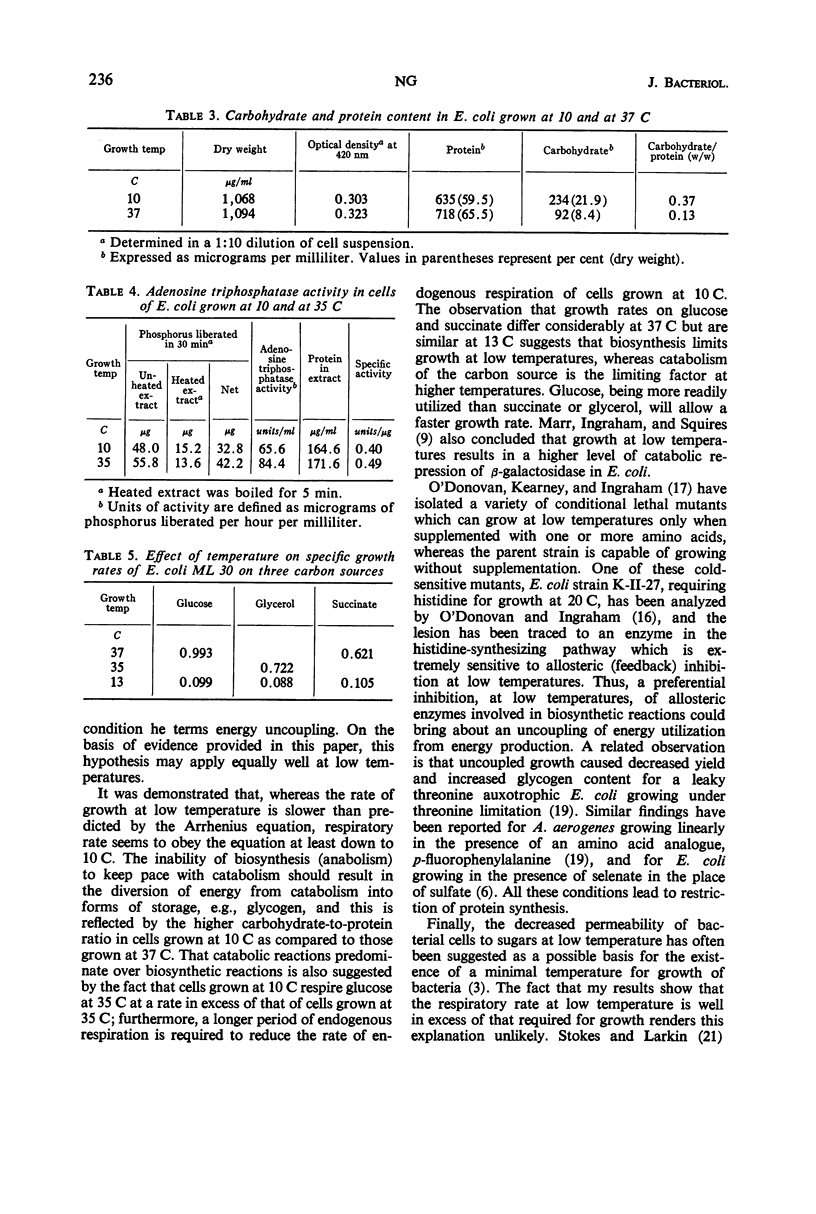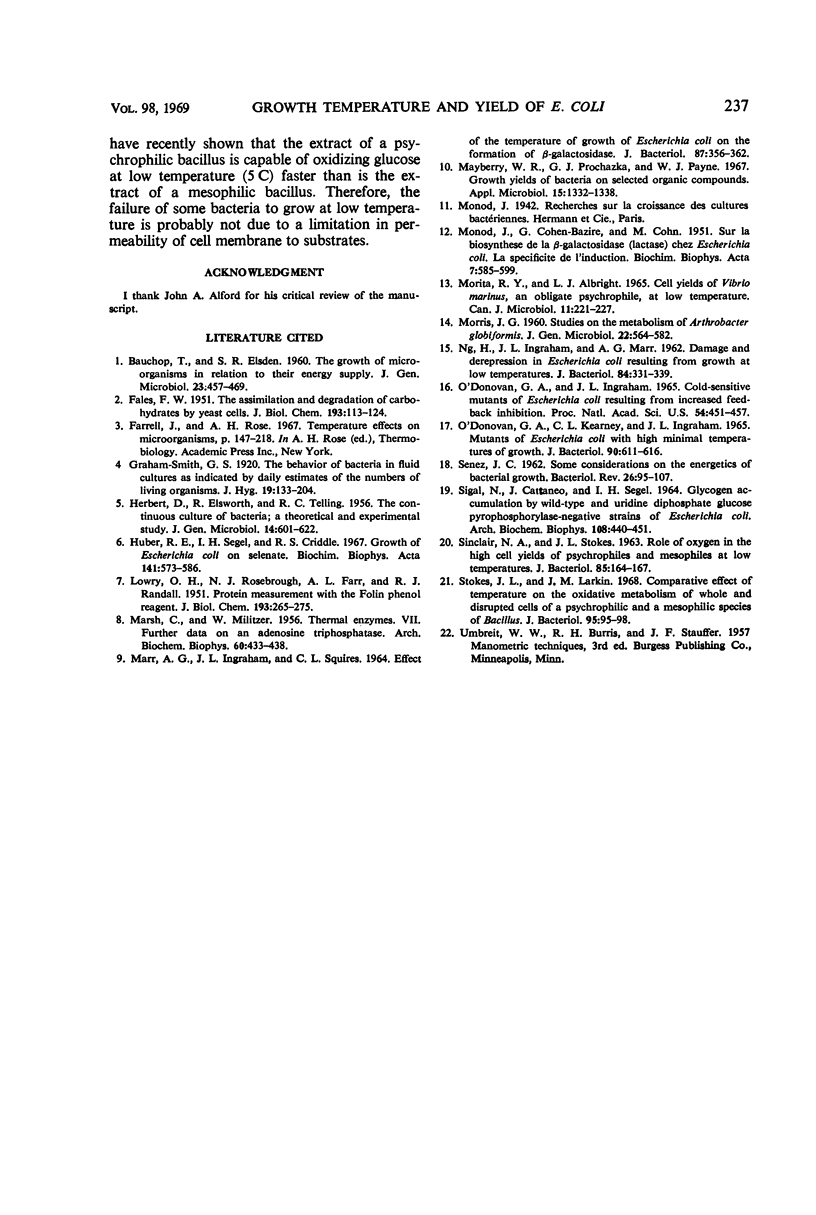Abstract
Studies of the relationship between yield coefficient and growth rate, as affected by temperature of growth, in Escherichia coli have shown that, over a wide range of temperature, yield is relatively constant until the specific growth rate falls below about 0.2 hr−1, at which point the yield begins to fall off precipitously. No intermediates of glucose metabolism in a form utilizable at higher temperatures could be found in the medium, and no toxic product was produced which limited growth. At 10 C, 37% of the carbon from glucose-UL-14C was assimilated into cellular material, whereas, at 30 C, 53% was assimilated. Cells grown at 10 C contained more carbohydrate than did cells grown at 37 C, and the glycogen-to-protein ratio of cells grown at 10 C was approximately three times higher than that of cells grown at 37 C. Adenosine triphosphatase activities of cells grown at 10 and 35 C were similar. Growth rates on glucose, glycerol, and succinate were quite similar at 10 C, but at 35 C growth was most rapid on glucose and slowest on succinate. The data suggest that the decrease in yield with decrease in temperature is a result of uncoupling of energy production from energy utilization.
Full text
PDF





Selected References
These references are in PubMed. This may not be the complete list of references from this article.
- BAUCHOP T., ELSDEN S. R. The growth of micro-organisms in relation to their energy supply. J Gen Microbiol. 1960 Dec;23:457–469. doi: 10.1099/00221287-23-3-457. [DOI] [PubMed] [Google Scholar]
- FALES F. W. The assimilation and degradation of carbohydrates by yeast cells. J Biol Chem. 1951 Nov;193(1):113–124. [PubMed] [Google Scholar]
- HERBERT D., ELSWORTH R., TELLING R. C. The continuous culture of bacteria; a theoretical and experimental study. J Gen Microbiol. 1956 Jul;14(3):601–622. doi: 10.1099/00221287-14-3-601. [DOI] [PubMed] [Google Scholar]
- Huber R. E., Segel I. H., Criddle R. S. Growth of Escherichia coli on selenate. Biochim Biophys Acta. 1967 Aug 29;141(3):573–586. doi: 10.1016/0304-4165(67)90186-9. [DOI] [PubMed] [Google Scholar]
- LOWRY O. H., ROSEBROUGH N. J., FARR A. L., RANDALL R. J. Protein measurement with the Folin phenol reagent. J Biol Chem. 1951 Nov;193(1):265–275. [PubMed] [Google Scholar]
- MARR A. G., INGRAHAM J. L., SQUIRES C. L. EFFECT OF THE TEMPERATURE OF GROWTH OF ESCHERICHIA COLI ON THE FORMATION OF BETA-GALACTOSIDASE. J Bacteriol. 1964 Feb;87:356–362. doi: 10.1128/jb.87.2.356-362.1964. [DOI] [PMC free article] [PubMed] [Google Scholar]
- MARSH C., MILITZER W. Thermal enzymes. VII. Further data on an adenosinetriphosphatase. Arch Biochem Biophys. 1956 Feb;60(2):433–438. doi: 10.1016/0003-9861(56)90448-9. [DOI] [PubMed] [Google Scholar]
- MONOD J., COHEN-BAZIRE G., COHN M. Sur la biosynthèse de la beta-galactosidase (lactase) chez Escherichia coli; la spécificité de l'induction. Biochim Biophys Acta. 1951 Nov;7(4):585–599. doi: 10.1016/0006-3002(51)90072-8. [DOI] [PubMed] [Google Scholar]
- MORITA R. Y., ALBRIGHT L. J. CELL YIELDS OF VIBRIO MARINUS, AN OBLIGATE PSYCHROPHILE, AT LOW TEMPERATURE. Can J Microbiol. 1965 Apr;11:221–227. doi: 10.1139/m65-028. [DOI] [PubMed] [Google Scholar]
- Mayberry W. R., Prochazka G. J., Payne W. J. Growth yields of bacteria on selected organic compounds. Appl Microbiol. 1967 Nov;15(6):1332–1338. doi: 10.1128/am.15.6.1332-1338.1967. [DOI] [PMC free article] [PubMed] [Google Scholar]
- NG H., INGRAHAM J. L., MARR A. G. Damage and derepression in Escherichia coli resulting from growth at low temperatures. J Bacteriol. 1962 Aug;84:331–339. doi: 10.1128/jb.84.2.331-339.1962. [DOI] [PMC free article] [PubMed] [Google Scholar]
- O'Donovan G. A., Ingraham J. L. Cold-sensitive mutants of Escherichia coli resulting from increased feedback inhibition. Proc Natl Acad Sci U S A. 1965 Aug;54(2):451–457. doi: 10.1073/pnas.54.2.451. [DOI] [PMC free article] [PubMed] [Google Scholar]
- O'donovan G. A., Kearney C. L., Ingraham J. L. Mutants of Escherichia coli with High Minimal Temperatures of Growth. J Bacteriol. 1965 Sep;90(3):611–616. doi: 10.1128/jb.90.3.611-616.1965. [DOI] [PMC free article] [PubMed] [Google Scholar]
- SENEZ J. C. Some considerations on the energetics of bacterial growth. Bacteriol Rev. 1962 Jun;26:95–107. [PMC free article] [PubMed] [Google Scholar]
- SIGAL N., CATTANEO J., SEGEL I. H. GLYCOGEN ACCUMULATION BY WILD-TYPE AND URIDINE DIPHOSPHATE GLUCOSE PYROPHOSPHORYLASE-NEGATIVE STRAINS OF ESCHERICHIA COLI. Arch Biochem Biophys. 1964 Dec;108:440–451. doi: 10.1016/0003-9861(64)90425-4. [DOI] [PubMed] [Google Scholar]
- SINCLAIR N. A., STOKES J. L. Role of oxygen in the high cell yields of psychrophiles and mesophiles at low temperatures. J Bacteriol. 1963 Jan;85:164–167. doi: 10.1128/jb.85.1.164-167.1963. [DOI] [PMC free article] [PubMed] [Google Scholar]
- Stokes J. L., Larkin J. M. Comparative effect of temperature on the oxidative metabolism of whole and disrupted cells of a psychrophilic and a mesophilic species of Bacillus. J Bacteriol. 1968 Jan;95(1):95–98. doi: 10.1128/jb.95.1.95-98.1968. [DOI] [PMC free article] [PubMed] [Google Scholar]


